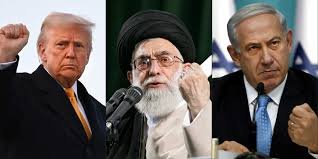How Iran stopped US, Israel from achieving their war goals
By The Taurean
Despite air raids and heavy damages, Tehran appears to have foiled Israeli and American attempts to trigger regime change and dismantle its nuclear programme
THE WORLDVIEW
June 29, 2025
THERE are broadly two ways to assess which side has won a war. One is the quantitative measure — evaluating which side suffered fewer losses. The other, more strategic approach, is to identify which party achieved its original objectives. Judged by both standards, Iran has emerged from its recent war with Israel more robust than many had expected.
Israel’s two stated objectives for initiating the military confrontation were straightforward, yet ambitious: first, to bring about regime change in Iran; second, to completely dismantle Iran’s nuclear programme. Yet both goals remain unrealised, leading many observers to question the wisdom and effectiveness of Israel’s military campaign.
From the outset, the regime change objective was a political non-starter. Iran’s internal dynamics offer few viable alternatives to the current clerical leadership. Moreover, wars imposed from external forces — particularly by adversaries long perceived as hostile — have historically tended to unify nations, not divide them.
The 2025 conflict was no exception. If anything, Israeli strikes and US backing only reinforced the Iranian public’s inclination to rally behind the flag. As one senior European diplomat privately observed: "Wars imposed from outside usually solidify national resolve, especially in societies that feel cornered or under siege."
This phenomenon has been well documented in modern conflicts — from Vietnam to Iraq. Even dissidents within Iran, some of whom are critical of the regime, viewed the foreign military campaign with suspicion, if not outright hostility.
The nuclear programme
Israel’s second aim — obliteration of Iran’s nuclear infrastructure — has also remained unachieved. Although Israeli airstrikes succeeded in damaging key facilities and laboratories, Iran’s scientific expertise and industrial capacity remain largely intact.
David Albright, president of the Institute for Science and International Security in Washington DC, said Iran may have retained the materials needed to rebuild the programme. Similarly, Jeffrey Lewis, professor at the Middlebury Institute of International Studies, noted that as much as 900 pounds of highly enriched uranium is still unaccounted for.
Rafael Grossi, Director-General of the International Atomic Energy Agency (IAEA), stated that Iran still possesses the “requisite knowledge and industrial infrastructure” to regenerate its programme if it so chooses. Going a step further, he claimed that Iran could resume uranium enrichment within months.
“They can have, you know, in a matter of months — maybe less than that — a few cascades of centrifuges spinning and producing enriched uranium,” Grossi told CBS News in an interview. “Frankly speaking, one cannot claim that everything has disappeared and there is nothing there,” he added, in a transcript of his interview on Face the Nation with Margaret Brennan.
The Defence Intelligence Agency of the Pentagon has issued similar assessments, underlining that Iran’s latent capabilities remain viable.
The question of damages
To be sure, Iran sustained significant losses. With a sanctions-ravaged economy and an ageing air force (most of its fighter jets dating back to the 1970s and 80s) Iran was always vulnerable to Israeli air superiority. Within 48 hours of the conflict’s onset, Israel had full command of the skies, enabling deep strikes against Iranian military and industrial infrastructure.
However, the material losses tell only half the story. Iran’s missile retaliation capacity, and resilient domestic production base allowed it to weather the assault better than expected. More importantly, Iran did not collapse —neither militarily nor politically.
Contrary to most pre-war assessments, by the war’s end Iran was gaining tactical momentum. Its ballistic missile units had begun striking Israeli military sites with increasing precision. According to retired US intelligence officials, had Iran not agreed to a ceasefire when it did, it might have inflicted serious and irreversible damage on Israeli strategic assets.
One former CIA officer noted: “Iran was starting to impose real costs. Tel Aviv was worried about escalation — not just the international reaction.” That’s why the ceasefire terms reflected a mutual desire to pause hostilities, rather than any decisive Israeli victory.
A strategic draw, or Tehran’s quiet win?
If we return to the two war-assessment criteria — damages sustained and objectives achieved — Iran may not have “won” in the conventional sense. But neither did it lose. In fact, Tehran retained its leadership, preserved the core of its nuclear ambitions, and concluded the war on terms not entirely unfavourable. For a country under decades of sanctions, with limited air capabilities, and facing two of the world’s most advanced militaries, mere survival is a strategic success.
This war has once again exposed the limits of military force in achieving political transformation, and underscored a familiar lesson: in protracted conflict, resilience can prove more decisive than superiority.
